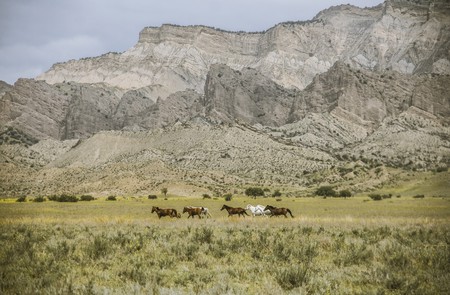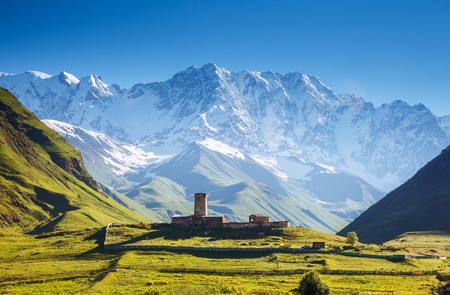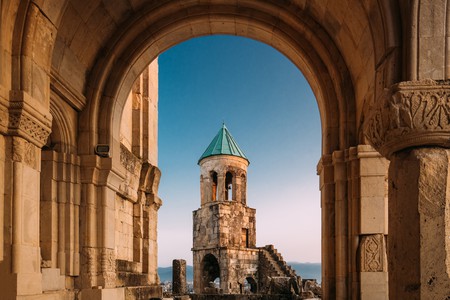Strengthening Families and Protecting Lives
© Great Start Georgia 2012 | 1-855-707-8277

It is still considered an underrated and mysterious destination by many – but if you’ve been to Georgia, you’ll fondly remember its charm, beauty and warm hospitality. And it might be a small nation, sitting between Europe and Asia, but it has a lot to offer – with ancient cities, Unesco World Heritage Sites, snowcapped mountains, lush nature and delicious wine. If you’re considering a trip, here are some interesting facts to stir your curiosity.
1. Georgia isn’t the country’s only name
Georgians call their country Sakartvelo. The name consists of two parts: Kartvel, which refers to an inhabitant of the central Georgian region of Kartli, and the circumfix sa-o stands for a general geographic identification meaning “land where the Kartveli live”. There are multiple theories as to where the English name of the country originated, but most support a connection to St George and agree that the name is derived from the Persian and Turkish version of the name George, Gorj and Gurju, which was itself derived from the Russian word Gruzia.
2. It’s the cradle of winemaking
Georgia has been producing wine for 8,000 years and is considered to be the birthplace of winemaking. This discovery was entirely accidental – Georgians found that if grape juice was poured in large earthenware vessels, called qvevri, and buried underground over winter, it would turn into wine. Unesco has listed the traditional Georgian winemaking method – through the use of qvevri – on its Intangible Cultural Heritage of Humanity list.

3. Georgia may be home to one of the oldest communities
An archaeological expedition to a site in Dmanisi found the oldest human skulls – some up to 1.8m years old – in the Caucasus, providing evidence that Georgia may be home to one of the oldest communities. Though six skulls were found, two have been given the Georgian names Zezva and Mzia and artists have worked to reconstruct their likeness.
4. It is one of the most ecologically diverse places in the world
Georgia has almost every type of climate, from subtropical and alpine to semi-desert, but its land is also conducive to agriculture, with 49 different types of soil. This makes the Georgian biosphere one of the most ecologically diverse on earth. Though a wide variety of species can be found all over the country, dense forests cover 43% and are populated by animals such as lynxes, bears and a small number of leopards.

5. The Georgian language is unique
The Georgian language is one of the most unique languages in the world and boasts its own alphabet. Though Georgian script has taken multiple forms – respectively Asomtavruli, Nuskhuri and Mkhedruli – the latter is the standard 33-letter script used by modern Georgians today. Asomtavruli and Nuskhuri are solely used by the Georgian Orthodox Church. Interestingly, though, standard Georgian is based on the Kartvelian dialect, one of 14 existing unique scripts in the Georgian alphabet.
6. It is home to a number of Unesco World Heritage Sites
There are three Georgian cultural sites listed on Unesco’s World Heritage list: the ancient city and former capital, Mtskheta, Gelati Monastery and the mountainous region of Upper Svaneti. Though these are incredible locations, it is worth mentioning that there are 15 other sites on a tentative list that could potentially be considered for a World Heritage Site nomination in the future.

7. It is known for its polyphonic folk music
Georgia is known for its tradition of polyphonic singing, a practice that was put on the Unesco Intangible Cultural Heritage of Humanity list in 2008. There are four notable types of polyphony: complex polyphony, which is common in the region of Svaneti; polyphonic dialogue over a bass background, popular in the region of Kakheti; and contrasted polyphony, consisting of three partially improvised sung parts characteristic of western Georgia.
8. It has some of Europe’s highest permanent settlements
The villages of Bochorna and Ushguli, at an altitude of 2,345m (7,694ft) and 2,100m (6,890ft) above sea level respectively, are some of the highest permanent settlements in Europe. Both are found in mountainous regions where the summer months are short and the winter seasons are snowy and breezy.

9. There is a recording of a traditional Georgian song in space
A recording of Chakrulo, a Georgian folk song usually sung at festivals and celebrations, was sent into space on the Voyager spacecraft. The Golden Record has 115 images encoded in analogue form, different natural sounds, traditional music from various countries, and spoken greetings in 59 languages. It’s like a message in a bottle, a welcome for any prospective life forms that may come across the probe.
10. Georgia contains two ancient European cities
Mtskheta and Kutaisi, both former capitals of Georgia, are among Europe’s oldest cities. Kutaisi served as the capital of the United Kingdom of Georgia from 1008CE to 1122CE and as the capital of the Imeretian Kingdom from the 15th century until 1810CE. Meanwhile, Mtskheta is most widely known as the capital of the early Georgian Kingdom of Iberia and the place where Georgia adopted Christianity in 326CE.

11. It is home to one of the world’s oldest Jewish communities
The Georgian Jewish community was one of the oldest communities in the country. It is worth noting that Georgian Jews have 2,600 years of history, whereas Ashkenazi Jews emigrated to Georgia in the 19th century following Russian annexation. Currently, as a result of a major wave of emigration in the 1990s, a large majority of Georgian Jews now reside in Israel.
12. The name Tbilisi derives from the old Georgian word for “warm”
The name of the country’s current capital, Tbilisi, is largely derived from an old Georgian word –tbili – for “warm”. The city foundation myth notes that when King Vakhtang I of Iberia’s falcon fell into a natural hot spring during a hunt, he was so impressed by the find that he cleared the forest and built the city of Tbilisi on that exact spot.
13. It is an undiscovered heliskiing destination
Abundant powder, spectacular views and wide open slopes make Georgia’s ski resort, Gudauri, an excellent destination for heliskiing enthusiasts. Gudauri is an up-and-coming ski destination with all the benefits, yet without the crowds of other European resorts. Don’t worry if you don’t consider yourself an adrenaline junkie, Gudauri still offers great slopes for beginner and intermediate skiers and snowboarders.
